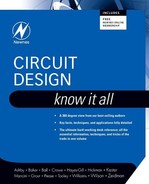Table of Contents
1.4 Alternating Voltage and Current
Chapter 2. The Semiconductor Diode
Chapter 3. Understanding Diodes and Their Problems
3.3 Other Strange Things that Diodes Can Do to You…
3.5 Diodes that Glow in the Dark, Efficiently
Chapter 4. Bipolar Transistors
Chapter 5. Transistors Field-Effect
Chapter 6. Identifying and Avoiding Transistor Problems
6.3 Power Transistors may Hog Current
6.5 Fabrication Structures Make a Difference
6.6 Power-Circuit Design Requires Expertise
6.7 MOSFETs Avoid Secondary Breakdown
Chapter 7. Digital Circuit Fundamentals
8.2 Decimal–Unsigned Binary Conversion
8.7 Hexadecimal-Binary Conversion
Chapter 9. Binary Data Manipulation
Chapter 10. Combinational Logic Design
Chapter 11. Sequential Logic Design
11.2 Level-Sensitive Latches and Edge-Triggered Flip-Flops
11.3 The D-Latch and D-Type Flip-Flop
11.6 Moore Versus Mealy State Machines
Chapter 13. Selecting a Design Route
Chapter 14. Designing with Logic ICs
15.1 Mixing Analog and Digital
15.2 Generating Digital Levels from Analog Inputs
15.3 Protection Against Externally Applied Overvoltages
15.5 Classic Data Interface Standards
15.6 High Performance Data Interface Standards
Chapter 16. DSP and Digital Filters
16.1 Origins of Real-World Signals and Their Units of Measurement
16.2 Reasons for Processing Real-World Signals
16.3 Generation of Real-World Signals
16.4 Methods and Technologies Available for Processing Real-World Signals
16.5 Analog Versus Digital Signal Processing
16.7 Finite Impulse Response (FIR) Filters
16.8 FIR Filter Implementation in DSP Hardware Using Circular Buffering
16.10 Infinite Impulse Response (IIR) Filters
16.11 IIR Filter Design Techniques
Chapter 17. Dealing with High-Speed Logic
References on Dealing with High Speed Logic
Chapter 18. Bridging the Gap between Analog and Digital
18.1 Try to Measure Temperature Digitally
18.3 The Ultimate Key to Analog Success
18.4 How Analog and Digital Design Differ
18.7 Set Your Foundation and Move On, Out of The Box
19.1 The Magical Mysterious Op-Amp
19.2 Understanding Op-Amp Parameters
19.4 Finding the Perfect Op-Amp
Chapter 20. Analog-to-Digital Converters
20.6 Microprocessor Interfacing
20.10 Internal Microcontroller ADCs
20.13 Dual-Function Pins on Microcontrollers
21.1 Instrumentation and Control Systems
21.5 Semiconductor Temperature Sensors
21.10 Driving High-Current Loads
21.13 Driving Mains Connected Loads
22.2 Fundamentals of Low-Pass Filters
22.6 Band-Rejection Filter Design
22.9 Filter coefficient tables
Chapter 23. Radio-Frequency (RF) Circuits
23.1 Modulation of Radio Waves
24.2 NonsinusoidaI Waveform Generators
24.4 Voltage-Controlled Oscillators and Phase Detectors
Chapter 25. EDA Design Tools for Analog and RF
25.1 The Old Pencil and Paper Design Process
25.2 Is Your Simulation Fundamentally Valid?
25.3 Macromodels: What Can They Do?
Chapter 27. Programmable Logic to ASICs
27.1 Programmable Read-Only Memory (PROM)
27.2 Programmable Logic Arrays (PLAs)
27.3 Programmable Array Logic (PALs)
27.4 The Masked Gate Array ASIC
Chapter 28. Complex Programmable Logic Devices (CPLDs)
28.6 CPLD Technology and Programmable Elements
28.8 Summary: CPLD Selection Criteria
Chapter 29. Field-Programmable Gate Arrays (FPGAs)
29.2 Configurable Logic Blocks
29.5 Programmable Interconnect
29.7 SRAM vs. Antifuse Programming
29.8 Emulating and prototyping ASICs
Chapter 30. Design Automation and Testing for FPGAs
30.8 VHDL Issues for FPGA Design
Chapter 31. Integrating Processors onto FPGAs
31.2 A Simple Embedded Processor
31.3 Soft Core Processors on an FPGA
Chapter 32. Implementing Digital Filters in VHDL
32.2 Converting S-Domain to Z-Domain
32.3 Implementing Z-Domain Functions in VHDL
32.4 Basic Low-Pass Filter Model
Chapter 33. Microprocessor and Microcontroller Overview
33.2 Single-Chip Microcomputers
Chapter 34. Microcontroller Toolbox
34.1 Microcontroller Supply and Reference
34.5 Voltage Monitors and Supervisory Circuits
34.6 Driving Bipolar Transistors
34.8 Reading Negative Voltages
Chapter 35. Power Supply Overview and Specifications
35.3 Off-the-Shelf or Roll Your Own
Chapter 36. Input and Output Parameters
36.4 Switch-on Surge, or Inrush Current
36.5 Waveform Distortion and Interference
36.8 Deriving the Input Voltage from the Output
36.10 Rectifier and Capacitor Selection
36.11 Load and Line Regulation
Chapter 38. Layout and Grounding for Analog and Digital Circuits
38.1 The Similarities of Analog and Digital Layout Practices
38.2 Where the Domains Differ—Ground Planes Can Be a Problem
38.3 Where the Board and Component Parasitics Can Do the Most Damage
38.4 Layout Techniques That Improve ADC Accuracy and Resolution
38.5 The Art of Laying Out Two-Layer Boards
38.6 Current Return Paths With or Without a Ground Plane
38.7 Layout Tricks for a 12-bit Sensing System
38.8 General Layout Guidelines—Device Placement
38.9 General Layout Guidelines—Ground and Power Supply Strategy
38.11 Did I Say Bypass and Use an Anti-Aliasing Filter?
39.1 The Hazards of Electricity
39.4 Design Considerations for Safety Protection
Chapter 40. Design for Production
42.4 The Value of MTBF Figures
Chapter 43. Thermal Management
